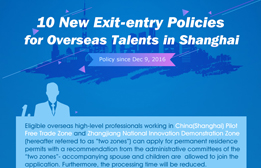Current Status and Future Planning of the City's Transportation
The city's traffic flows are stable
A highway network of “three rings, one crossing and multiple spokes” and “three vertical and three horizontal” main roads in the central city has been established. In 2014, the city had 4,852 km of roads including 187.3 km of highways. The road space totaled 105.5 million sq meters. Four bridges and 12 tunnels across the Huangpu River had a total of 85 lanes. There have been 23 bridges across the Suzhou Creek. Thus, an integrated transportation network has been established. Up to the end of 2014, the city had 84 transportation hubs, and seven P+R parking lots with a toal of 2,729 parking spaces.
Traffic management have been improved progressively
The permanent population of Shanghai in 2014 totaled 24.26 million. Registered vehicles totaled 3.04 million. “Car plate quota and bidding” has controlled the excessive growth of cars and the car ownership rate was 93 cars per 1,000 people in 2014.
Measures such as traffic flow and environment pollution control have been strengthened and emission increase has been curbed. Graded traffic congestion management system was established and real-time traffic information was announced regularly based on big data and information technology. Comprehensive measures including prioritizing public transportation, dedicated bus lanes, enhancing parking management, extending restricted time on non-Shanghai-plate cars, and pilot restrictions at regular congestion locations are applied according to congestion levels.
Comprehensive plan and strategy of traffic infrastructures
Strengthen the seamless connection between traffic hubs such as Pudong airport with express railway network, coordinate group development of airport in the region, and reserve express railway lines for airports. Deepen the reform of low-altitude airspace administration and reserve resources for airports of general aviation.
Increase the capacity to serve Zhejiang, Jiangsu, Anhui, south side of Yangtze River Valley, and middle region of the Beijing-Guangzhou belt as well as consolidated cargo shipment channel for sea-rail and air-rail relay.
Efforts will be made to develop high-end shipping services, integrate port resources, take advantage of Yangtze River, and increase the portion of river-river and river-sea relay business.
Move public transportation to a low-carbon eco-system (Transit-Oriented Development), improve infrastructure for low-speed vehicles, and enable differentiated traffic policies.

 Print
Print Mail
Mail




